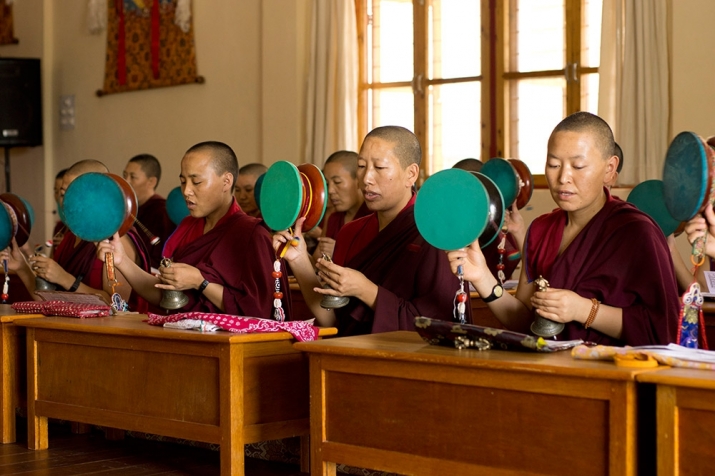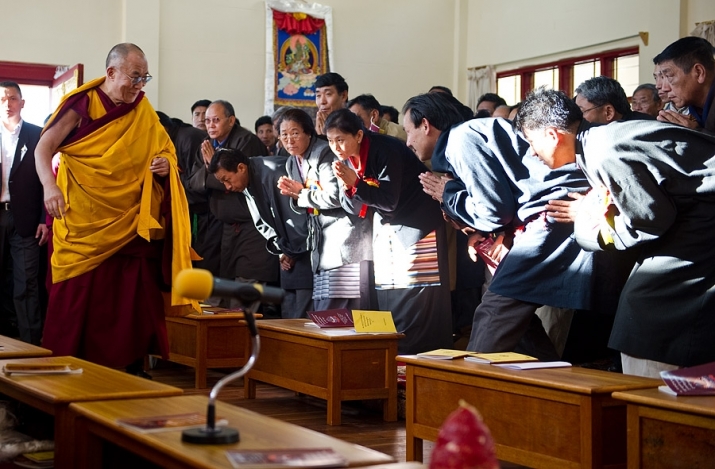NEWS
Shugsep Nunnery Celebrates Fifth Anniversary
 Nuns of Shugsep Nunnery and Institute. From buddhistwomenseducationalsociety.org
Nuns of Shugsep Nunnery and Institute. From buddhistwomenseducationalsociety.orgNuns of Shugsep Nunnery and Institute on the outskirts of Dharamsala on Monday marked the fifth anniversary of the inauguration of the center by His Holiness the Dalai Lama. The nunnery is now home to 50 Tibetan nuns of the Nyingma school of Tibetan Buddhism, many of whom risked their lives fleeing imprisonment and torture in Tibet to find refuge in northern India.
The original Shugsep Nunnery in Tibet, destroyed during China’s Cultural Revolution, was home to some of Tibet’s most illustrious Buddhist practitioners, including one of the best-known female teachers of the last century, Shugsep Jetsun (1852–1953).
The Tibetan scholar Lobsang Lhalungpa (1926–2008), who met Shugsep Jetsun in the early 1940s, described her as “an extraordinary woman, small in stature, with a serene face radiating compassion and sensitivity. . . . In her presence we felt an awesome power that permeated our whole stream of being. . . . Her teachings and blessings have given me inner strength and inspiration ever since. To me she was the personification of the great woman teachers of Tibet.” (Tibetan Nuns Project)
By the 1980s, the nuns of Shugsep had partially rebuilt their nunnery in Tibet, despite regular harassment by the Chinese authorities. However, many of the nuns joined demonstrations in the Tibetan capital, Lhasa, during the 1980s and 1990s, and as a result were once again expelled; many were also imprisoned and tortured. In the early 1990s, a large number decided to flee, trekking through the Himalayas to Nepal before seeking refuge in Dharamsala.
“My friend threw a rock and the Chinese police arrested us both,” said one of the nuns who had participated in the demonstrations. “We were imprisoned and tortured. We escaped and reached the Nepalese border, where we were arrested again. We were imprisoned this time for two years and nine months in Sikkim. We were placed in six different prisons, where we met many monks and nuns who had also tried to enter India. Finally we were sent back to the Tibetan border.
“Fearing for our lives, we walked for one month in the mountains. We were weak and sick. We were without food for days. By divine grace, we met some Western tourists trekking with a Nepalese porter. They gave us food and clothing and treated our frostbite. On the roadside, we found four Tibetans who had died from the cold: a boy, a monk, a lady, and a soldier. We carried their valuables to give as offerings at the temple in Dharamsala, as they would have wanted.” (Tibetan Nuns Project)
 His Holiness the Dalai Lama arriving at the assembly hall during the inauguration of Shugsep Nunnery and Institute on 7 December 2010. Photo by Tenzin Choejor. From dalailama.com
His Holiness the Dalai Lama arriving at the assembly hall during the inauguration of Shugsep Nunnery and Institute on 7 December 2010. Photo by Tenzin Choejor. From dalailama.comAfter reaching India, the nuns were forced to camp in the open as there were almost no facilities for exiled nuns at the time. Despite the hardships, the nuns were determined to remain together to maintain the unique Nyingma traditions of Shugsep, and with support from the Tibetan Nuns Project and the Tibetan Women’s Association, Shugsep Nunnery was eventually re-established in northern India.
The majority of the nuns now living and studying at Shugsep Nunnery and Institute come from the original Shugsep Nunnery, where they were primarily engaged in memorizing scriptures and meditation. The new nunnery offers them a nine-year academic program of Buddhist philosophy, traditional monastic debate, and Tibetan and English language studies.
See more
Shugsep Nunnery celebrates 5th anniversary of inauguration (Tibetan Nuns Project)
Shugsep (Tibetan Nuns Project)
Shugsep Jetsun, the Story of a Tibetan Yogini (Tibetan Nuns Project)
Shugsep Nunnery and Institute Inauguration (His Holiness the 14th Dalai Lama)
Tibetan Nuns Project (Homepage)
Tibetan Women’s Association (Homepage)














